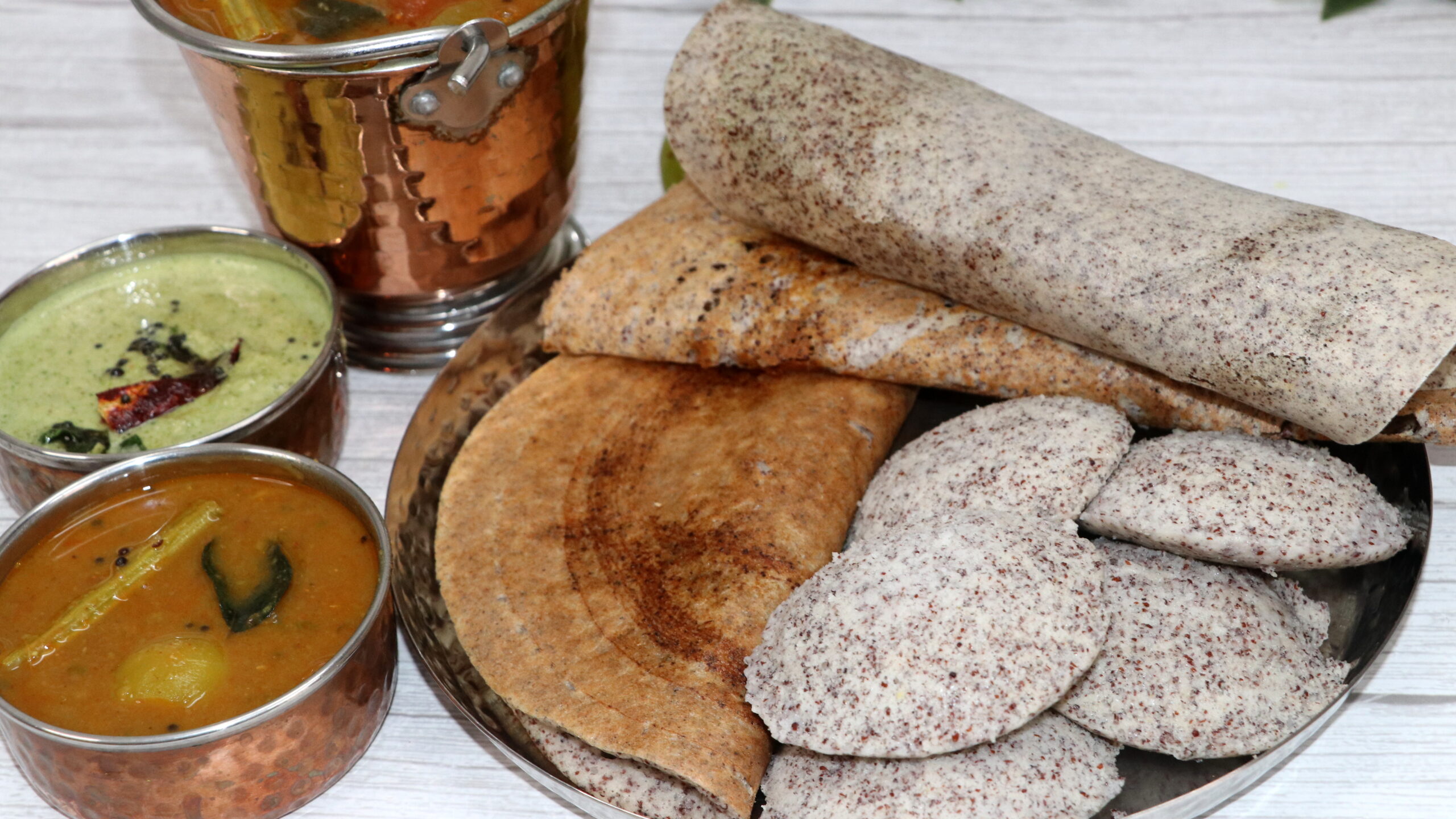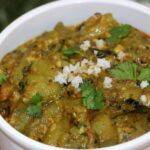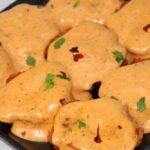Ragi, also known as finger millet, is a powerhouse of nutrition. When incorporated into your daily diet, it now only boosts your calcium level but also helps in managing blood sugar, making it a great choice for people of all ages. Today we’re going to make Ragi Idli and Dosa, a healthy twist on traditional South Indian favorites. These soft idlis and dosas are not just delicious but also packed with probiotics, iron and other essential nutrients.
Whether it’s for breakfast, lunch or dinner. This recipe is perfect for when you want something light yet filling. Plus, the fermentation process adds natural probiotics, making this dish great for your gut health. The combination process add natural probiotics, making this dish great for your gut health. The combination of rice, urad ki dal, and ragi offers a perfect balance of flavors, and it’s super easy to prepare.
Let’s bring this wholesome meal into your kitchen and enjoy the health benefits of ragi with every bite!
Do visit my other recipes, Veg Chili Mili with Paneer – A Colorful, Restaurant-Style Delight!
- Stuffed Paneer Paratha & Creamy Makhana Raita Recipe
- Mushroom Kaju Masala Recipe | Easy
- & quick Mushroom Cashew Masala,
- Kadu Puri with Aloo Matar ki Sabji,
- Lauki Kofta Curry recipe,
- Hotel Style Paneer Makhani Recipe,
- Dal Ki Dulhan | Dal Pitthi,
- Sev Tamatar Ki Sabji recipe,
- Lauki ki Sabji,
- Torai Ki Sabji ( Ridge Gourd),
- Kaju Paneer Masala Recipe,
- Paneer Korma,
- Palak Matar Paneer Recipe
- Zucchini ki sabji
- Dhaba Style Amritsari Chole Bhature
- Bedami Puri & Aloo ki Sabzi
- Protein-Rich Chole Paneer Recipe
- 10-minute Buttermilk Potato Curry (Aloo ki Chaas Wali Sabzi)
further, do check my other recipes collection All recipes
Why eat ragi idli and dosa?
Ragi Idli and Dosa are not just delicious, but they also pack a punch when it comes to health benefits. Ragi, also known as finger millet, is a superfood that provides multiple essential nutrients like calcium, fiber and iron. It’s an excellent addition to your diet if you’re looking to manage your blood sugar levels, improve digestion and strengthen bones. The fermentation process of idli and dosa.
also enhances the nutritional value by increasing probiotics, which are great for gut health.
- Rich in calcium : Ragi is one of the best natural sources of calcium, promoting bone health and helping prevent conditions like osteoporosis.
- Good for Diabetics : The high fiber content in ragi helps in controlling blood sugar level spikes and managing diabetics.
- Weight management : Ragi keeps you fuller for longer, which can help in managing weight.
- Heart – Healthy : Packed with antioxidants, ragi helps in reducing cholesterol and supports heart health.
- Improve digestion : The fermented batter is a natural source of prebiotics, which aids digestion and keeps your gut healthy.
- Anti-aging : The antioxidants present in ragi combat oxidative stress, promoting healthy skin and slowing down the aging process.
Video
Ingredient
- Rice – 1 cup
- Ragi (finger millet) – 1 cup
- Urad dal – 1 cup
- Fenugreek seeds – 1/4 tsp
- Poha – (flattened rice) – 1/4 cup
- Salt – 1/2 tsp
- Water – as required
Method
Step 1 – Prepare Idli / Dosa Batter
- Firstly, take a large bowl than add 1 cup of rice, 1 cup of ragi and 1 cup urad ki dal. Next add 1/4 tsp fenugreek seeds to it.
- Wash them thoroughly 2 – 3 times with water to remove impurities. After washing, add enough water to cover the grains, and let them soak for about 4 – 5 hours.
- After soaking the rice and urad dal, add 1/4 cup of soaked poha (flattened rice) to the mixture. This helps in making the idlis softer.
- Now drain the water and transfer the soaked rice, ragi and urad dal mixture to a grinder. Add a little water and grind it into a smooth paste.
- Make sure the batter is thick but smooth. Once done, transfer the batter into a bowl. Add some more water to the grinder to rinse it and pour it into the bowl. This ensures that no batter is wastes.
- Mix the batter well with your hands to incorporate air, which helps the batter ferment better.
- Now cover it with lid and let it rest overnight or for about 8 – 10 hours in a warm place. The batter will ferment and rise, becoming light and fluffy.
- Once the batter is fermented, add 1/2 tsp of salt and mix it gently. Idli / dosa batter is ready.
Step 2 – Prepare Idli
- Now first prepare idli, so grease the idli molds with a little oil, pour the batter into each mold, and place them in a steamer.
- Steam for 12 – 15 minutes on medium flame or until the idlis are cooked well through.
- You can check by inserting toothpick – if it comes out clean, the idlis are ready. Let them cool for a few minutes, then remove them from the molds.
Step 3 – Prepare Dossa
- Heat a tawa or cast iron pan on medium heat. Pour a ladle of the batter in the center and spread it in a circular motion to make a thin dosa. Once bubbles start appearing , drizzle a little or oil around the edges. Cook until it turns golden and crisp.
- Flip it over and cook the other side for a minute.
- Crispy ragi dosa is ready.
Step 4 – Serving
Serve the ragi Idlis and dosa with sambar and coconut chutney or your favorite dip. Both are delicious and packed with health benefits.
Enjoy this nutritious and delicious Ragi Idli and Dosa with your family. It’s an easy way to include the goodness of ragi in your diet while enjoying traditional flavors. Make it a part of your weekly meal plan and enjoy its benefits for a healthy lifestyle!
Tips
- The key to soft idlis and crispy dosas is proper fermentation. Keep the batter in a warm place for at least 8 – 10 hours. In cold weather, you can place the batter in an oven (turned off) with the light on for batter results.
- Adding poha (flattened rice) to the batter enhances the softness of ildis. It’s a great tip to ensure your idlis come out fluffy every time.
- For idlis, keep the batter thick and fluffy. For dosa, slightly dilute the batter with water to get a spreadable consistency. The dosa batter should be thin enough to spread easily but not too watery.
- Always grease your idli molds before pouring in the batter to ensure the idlis don’t stick and come out smoothly.
- Use a hot tawa and spread the batter thinly to make the dosa more crispier. Drizzle ghee or oil around the edges for extra crispiness.
- You can store the batter in the fridge for up to 2 – 3 days after fermentation. This makes it convenient to prepare fresh idlis or dosas anytime.
- By following these tips, you can prepare Ragi Idli and Dosa turn out perfect every time!

Vishakha's Kitchen
Join me on a delightful journey through the world of flavors and traditions! At Vishakha's Kitchen




